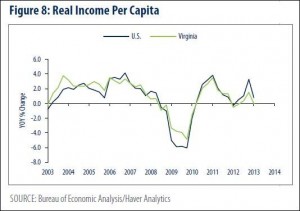by James A. Bacon
Yesterday, when asking how long Virginia universities could defy the national decline in student enrollments, I spoke just a hair too soon. I quoted 2012-2013 data to the effect that Virginia public higher education institutions were holding their own. Unbeknownst to me, the State Council on Higher Education for Virginia (SCHEV) was releasing updated enrollment numbers at a board meeting the very same day.
Turns out that enrollment at state colleges and universities fell below 400,000 this fall for the first time since 2008. In her Times-Dispatch article, reporter Karin Kapsidelis does not tell us how big of a tumble that was percentage-wise, but it was sufficient to cause considerable consternation among SCHEV board members.
The council then proceeded simultaneously to (a) bemoan the 78% increase in the number of students requiring financial aid since 2011, and (b) endorse tuition increases that would make college even more unaffordable. SCHEV estimates an average tuition increase in 3.7% will be needed to just to support its priorities of paying for faculty raises and covering maintenance costs of new buildings coming online in fiscal year 2016.
 Let us ask ourselves if there might be any connection between rising tuition and the increasing need for financial aid. Let’s see now… Real per capita incomes in Virginia have barely budged since 2011, yet tuition, fees and other college-related expenses have ratcheted ever higher at a rate considerably faster than inflation. If public colleges follow SCHEV’s recommendations and continue jacking up tuition by 3.7% annually, and if wages continue to stagnate, then college attendance, already unaffordable for many, will become even more unaffordable. As college becomes even more unaffordable, enrollments will continue to drop. This is not rocket science, people!
Let us ask ourselves if there might be any connection between rising tuition and the increasing need for financial aid. Let’s see now… Real per capita incomes in Virginia have barely budged since 2011, yet tuition, fees and other college-related expenses have ratcheted ever higher at a rate considerably faster than inflation. If public colleges follow SCHEV’s recommendations and continue jacking up tuition by 3.7% annually, and if wages continue to stagnate, then college attendance, already unaffordable for many, will become even more unaffordable. As college becomes even more unaffordable, enrollments will continue to drop. This is not rocket science, people!
It is true that the decline in state support is partly to blame for the increasing cost of going to college. But so has the growth in administrative overhead, student fees (much of which goes toward athletic programs), and the cost of fancy food courts and new dormitories. Moreover, public colleges have continued to build new physical facilities, raising the question of whether they have over-built. Indeed, one of SCHEV’s highest priorities for increased revenue is to cover the growing cost of building operations.
If you build more buildings in anticipation of ever-rising enrollments and those enrollments don’t occur, what happens? You still have to pay the bonds used to finance the building construction, and you still have to pay to maintain the buildings. Either you raise tuition to cover the higher costs, which makes your institution more unaffordable… which drives down enrollment… or you scrimp on maintenance, which means your facilities go to hell… which drives down enrollment.
Virginia’s system of higher education is nearing a crisis but the educational and political establishment is unwilling to face to underlying economic realities.


